Simple Business Case Template
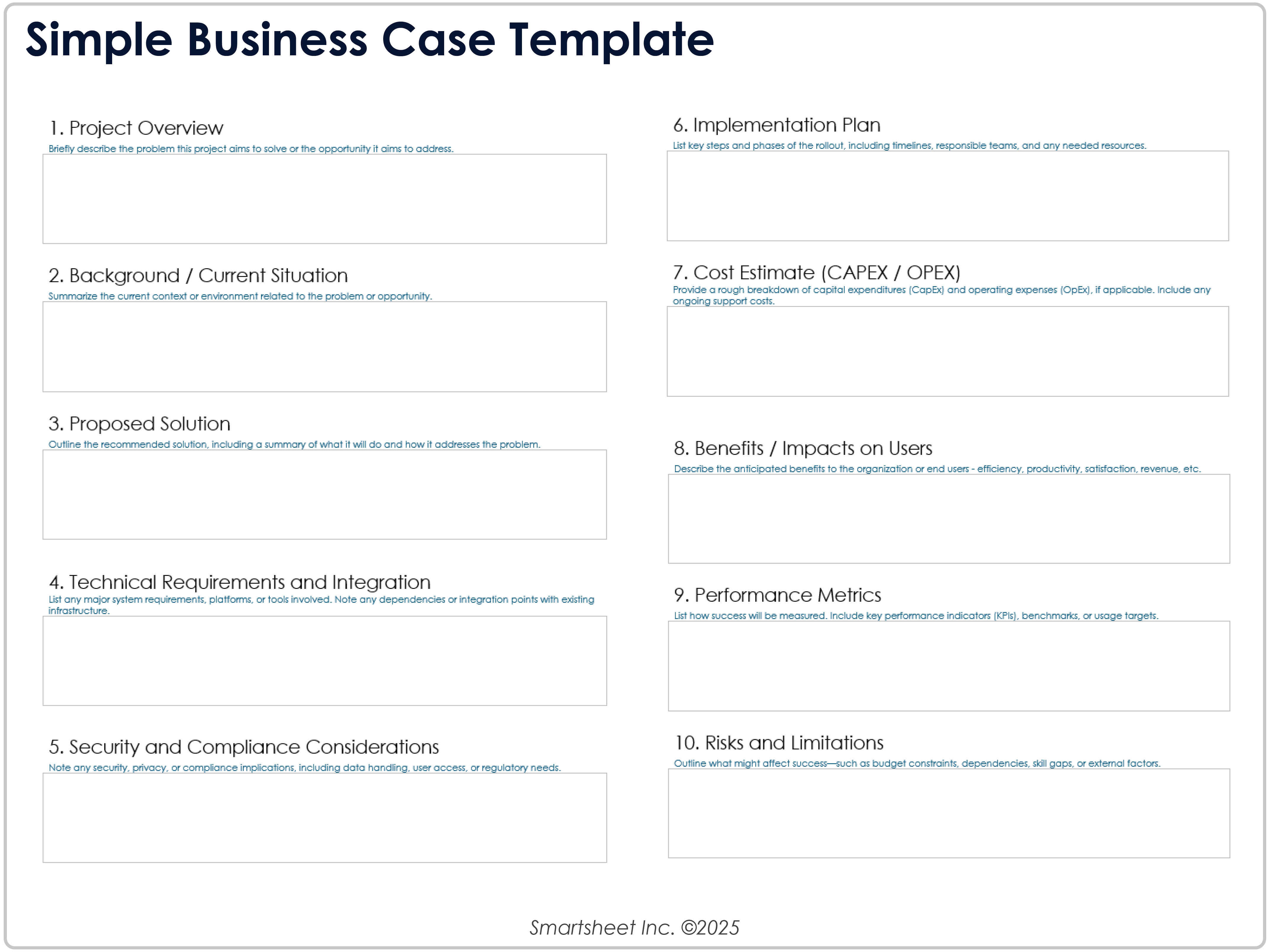
Download a Simple Business Case Template for
Excel
|
Microsoft Word
|
Adobe PDF
| Google Docs
When to Use This Template: Use this simple business case template to outline a project’s value without building a full financial model or business justification deck. It’s especially useful in the early stages of planning or when requesting internal approval for small to mid-sized initiatives.
Notable Template Features: This template includes clear sections such as Project Overview, Background/Current Situation, Proposed Solution, and Implementation Plan. The template also features dedicated fields called Technical Requirements & Integration, Security & Compliance Considerations, Cost Estimate (CapEx/OpEx), Performance Metrics, and Risks & Limitations to support informed decision making.
Explore free, real-world business case analysis examples to discover how successful proposals align financial logic with strategic impact across industries.
Business Case Presentation Template
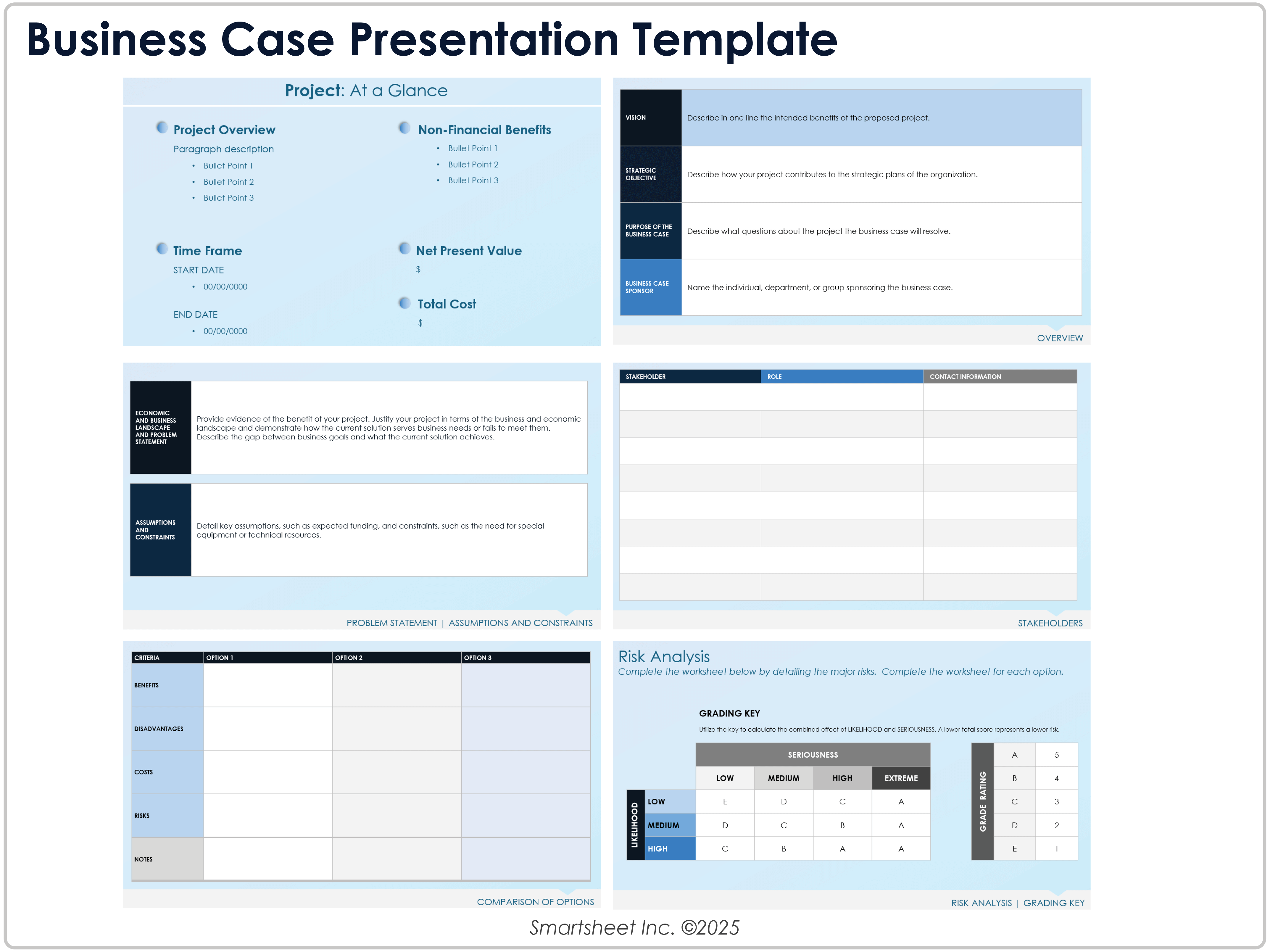
Download a Business Case Presentation Template for
PowerPoint
| Google Slides
When to Use This Template: Use this business case presentation template to pitch a proposal visually to stakeholders, board members, or leadership. You can use it during planning meetings, executive reviews, or funding requests where clarity and brevity are essential.
Notable Template Features: This template organizes slides by topic, including slides for the business case problem statement, proposed solution, estimated costs, and benefits or ROI. It also includes a summary slide with visuals pulled from data tables or charts, offering a quick snapshot of decision points.
Kick off your initiatives with project charter templates that turn loose ideas into focused action by clarifying goals, securing stakeholder buy-in, and laying the groundwork for real results.
One-Page Business Case Template
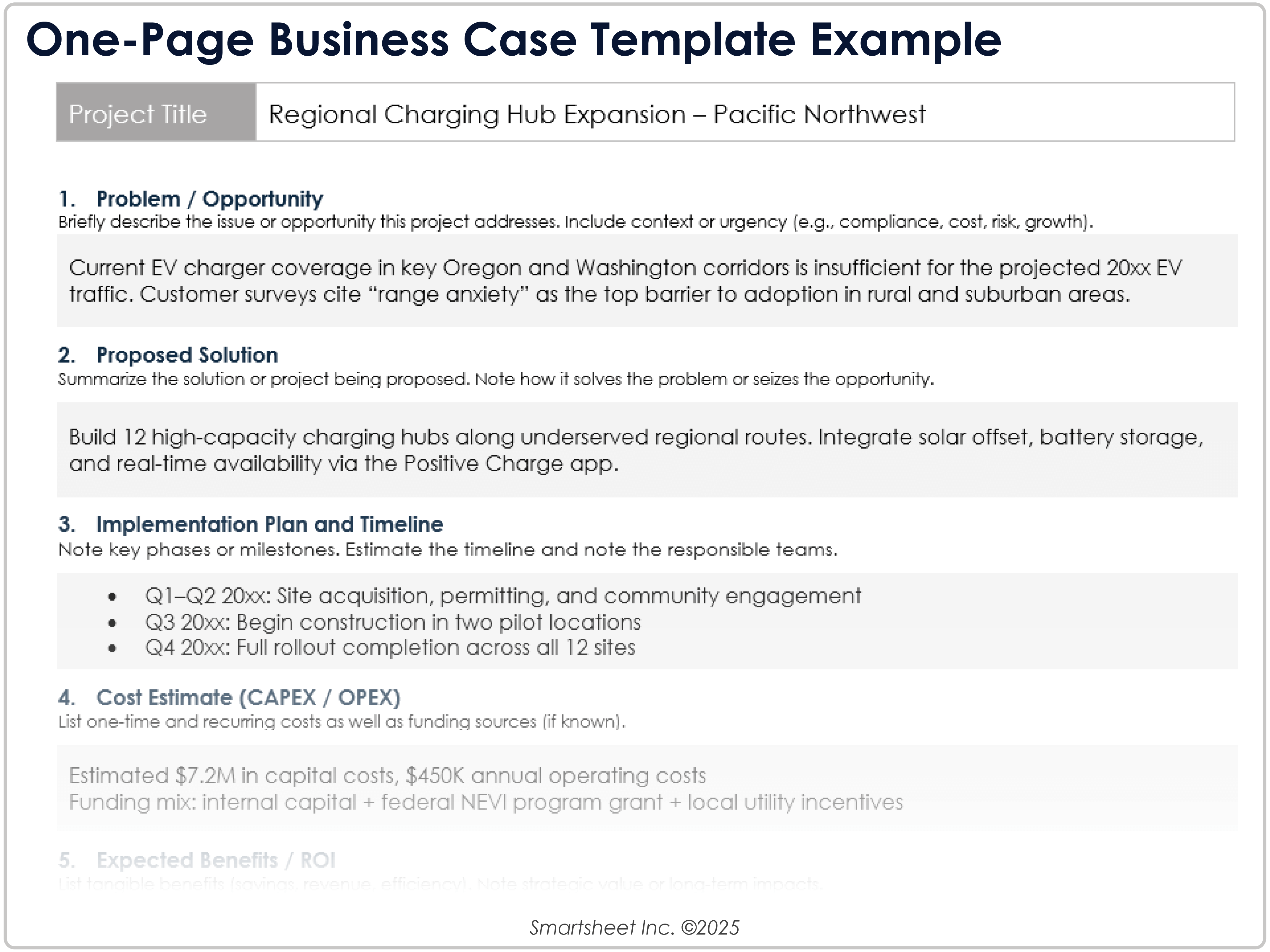
Download Blank and Sample Versions of a One-Page Business Case Template for
Microsoft Word
|
Adobe PDF
| Google Docs
When to Use This Template: Use this one-page business case template to communicate the essentials of a project quickly to executives or stakeholders with limited bandwidth. It works well for pilot proposals, fast approvals, or projects with a narrow scope.
Notable Template Features: This template features key sections to detail the problem and opportunity, proposed solution, cost estimate, and expected benefits onto a single page. It also includes sections for recommendations and next steps as well as for the implementation plan and timeline to ensure actionability without overwhelming detail.
Browse free business templates designed to support planning, operations, and reporting across project management, finance, HR, and more.
Lean Business Case Template
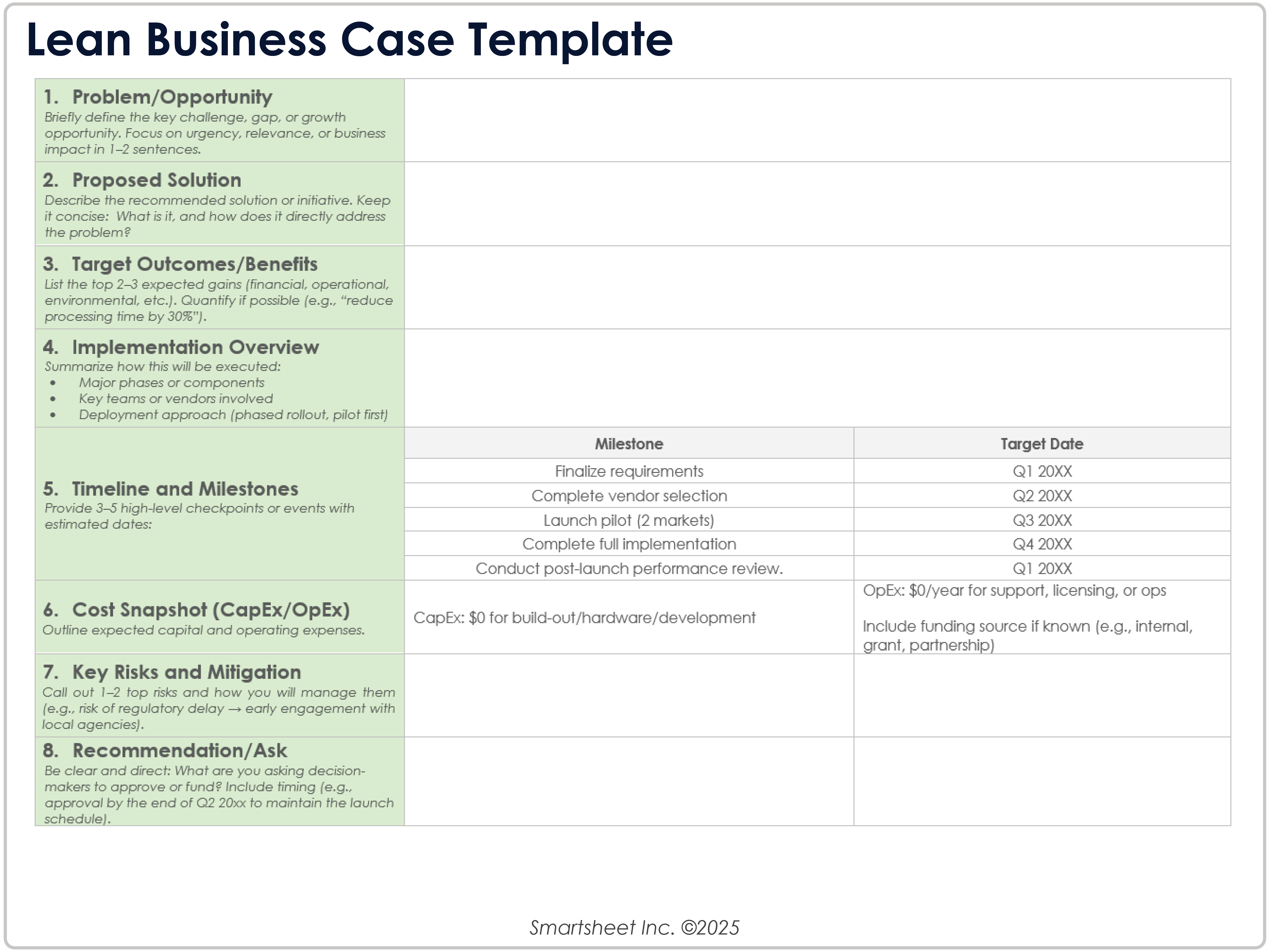
Download a Lean Business Case Template for
Microsoft Word
|
Adobe PDF
|
PowerPoint
When to Use This Template: This Lean business case template is useful for Agile teams, startups, or departments who need to vet ideas, validate initiatives, and get early-stage concept approvals quickly and with minimal overhead.
Notable Template Features: This template includes sections to detail the business case problem, opportunity, proposed solution, target outcomes and benefits, and key risks and mitigation. It also includes structured sections called Timeline of Milestones and Cost Snapshot (CapEx/OpEx).
Capture and showcase your organizational success stories by utilizing a range of customizable case study templates.
Business Analysis Business Case Template
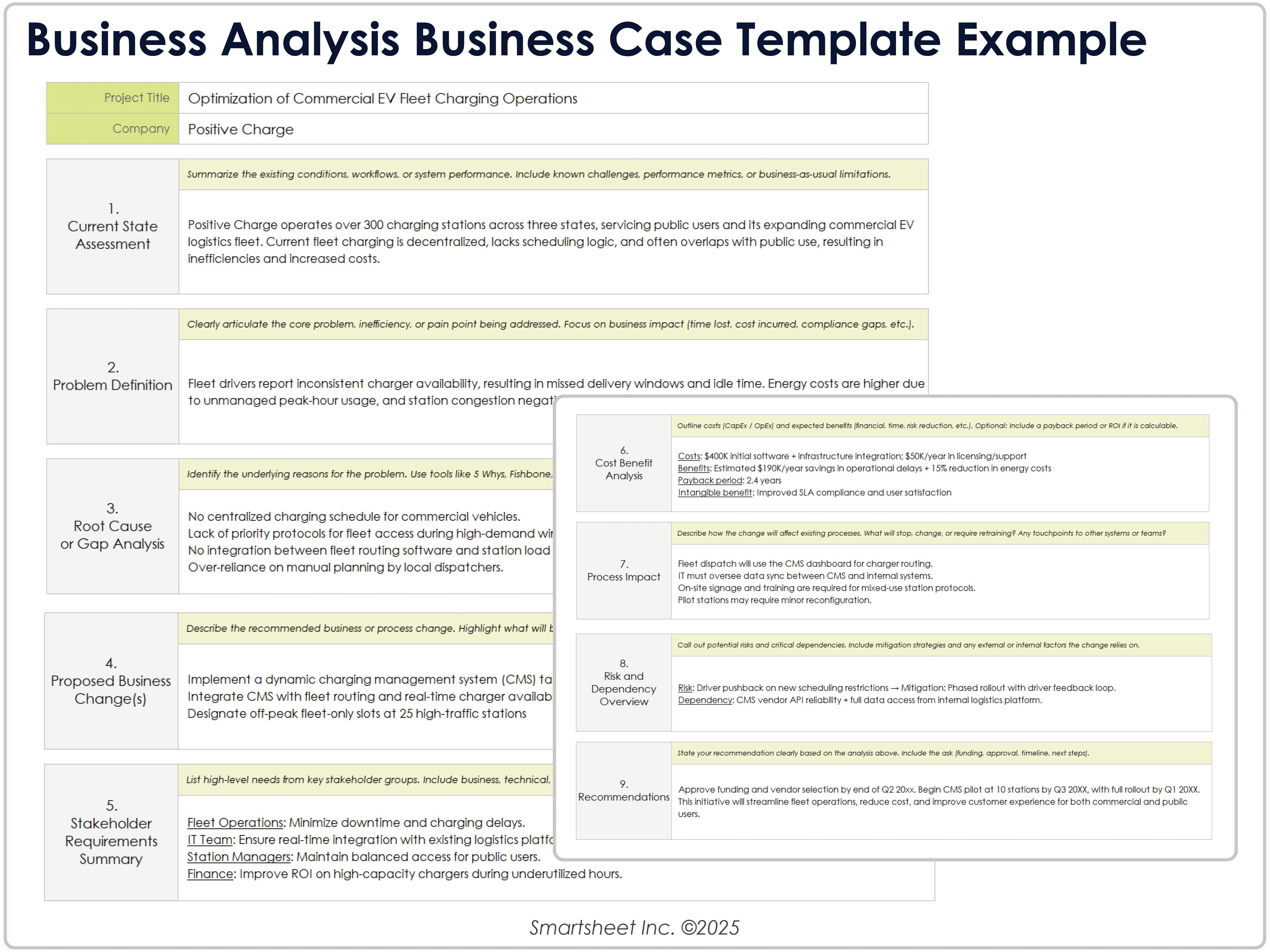
Download Blank and Sample Versions of a Business Analysis Business Case Template for
Excel
|
Microsoft Word
|
Adobe PDF
When to Use This Template: Ideal for process analysts, product owners, or operations leads, this business analysis business case template supports in-depth evaluations of existing systems and proposed changes. It works well during optimization initiatives or transformation planning.
Notable Template Features: This template includes detailed fields to record a current state assessment, root cause of gap analysis, process impact, and cost-benefit analysis. It concludes with a clear section for recommendations.
Outline your strategy, financial projections, and goals by choosing from a selection of Excel business plan templates.
Project Business Case Template
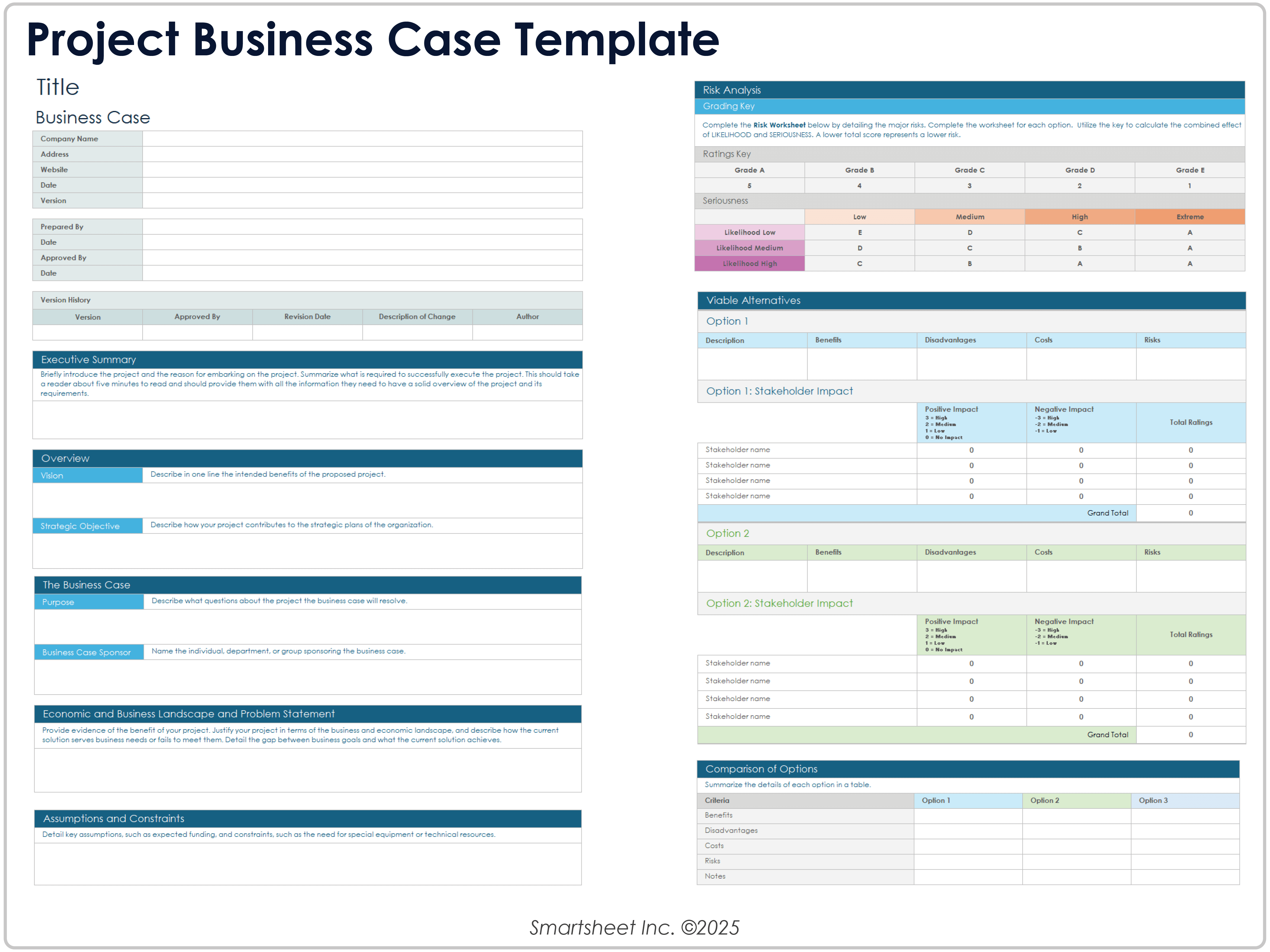
Download a Project Business Case Template for
Excel
|
Microsoft Word
|
PowerPoint
| Google Docs
When to Use This Template: Use this template to evaluate whether a specific project is feasible by breaking down scope, risk, and returns before proceeding. It’s frequently used in a project management office (PMO) or cross-functional settings.
Notable Template Features: This template features key sections called Project Description, Objectives, Scope, Budget & Resources, and Project Risks. It also includes a section called Stakeholder Analysis, which makes this format particularly useful for alignment and buy-in.
Startup Business Case Template
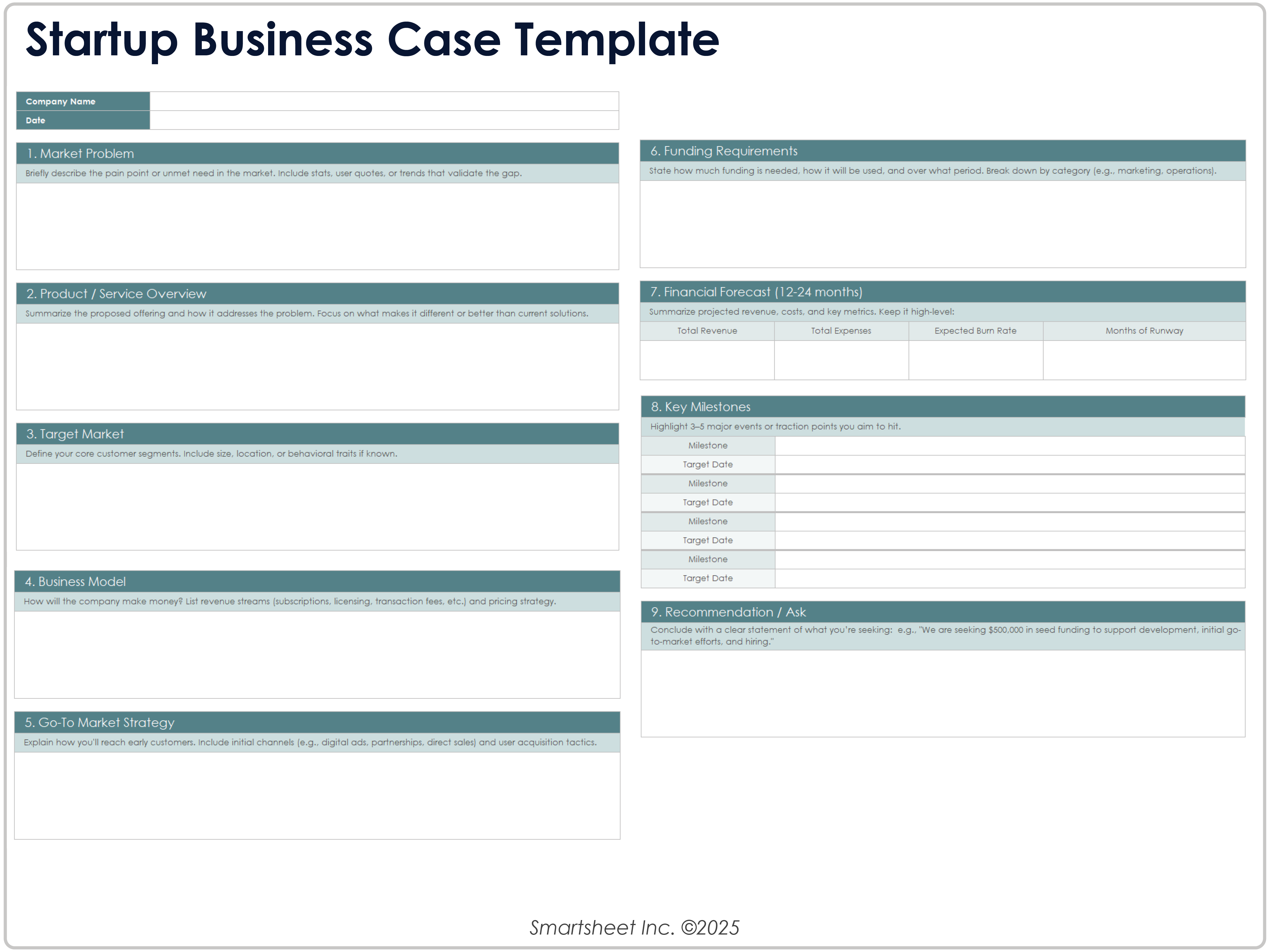
Download a Startup Business Case Template for
Excel
|
Microsoft Word
|
Adobe PDF
| Google Sheets
When to Use This Template: This startup business case template is designed for founders and early-stage teams. It’s a great tool for pitching to investors, grant committees, or internal stakeholders, and is helpful for introducing a new concept or MVP.
Notable Template Features: This template includes fields called Market Problem, Product/Service Overview, Target Market, and Financial Forecast (12–24 Months). Clear sections for the go-to-market strategy and key milestones round out its strategic value.
Small Business Case Template
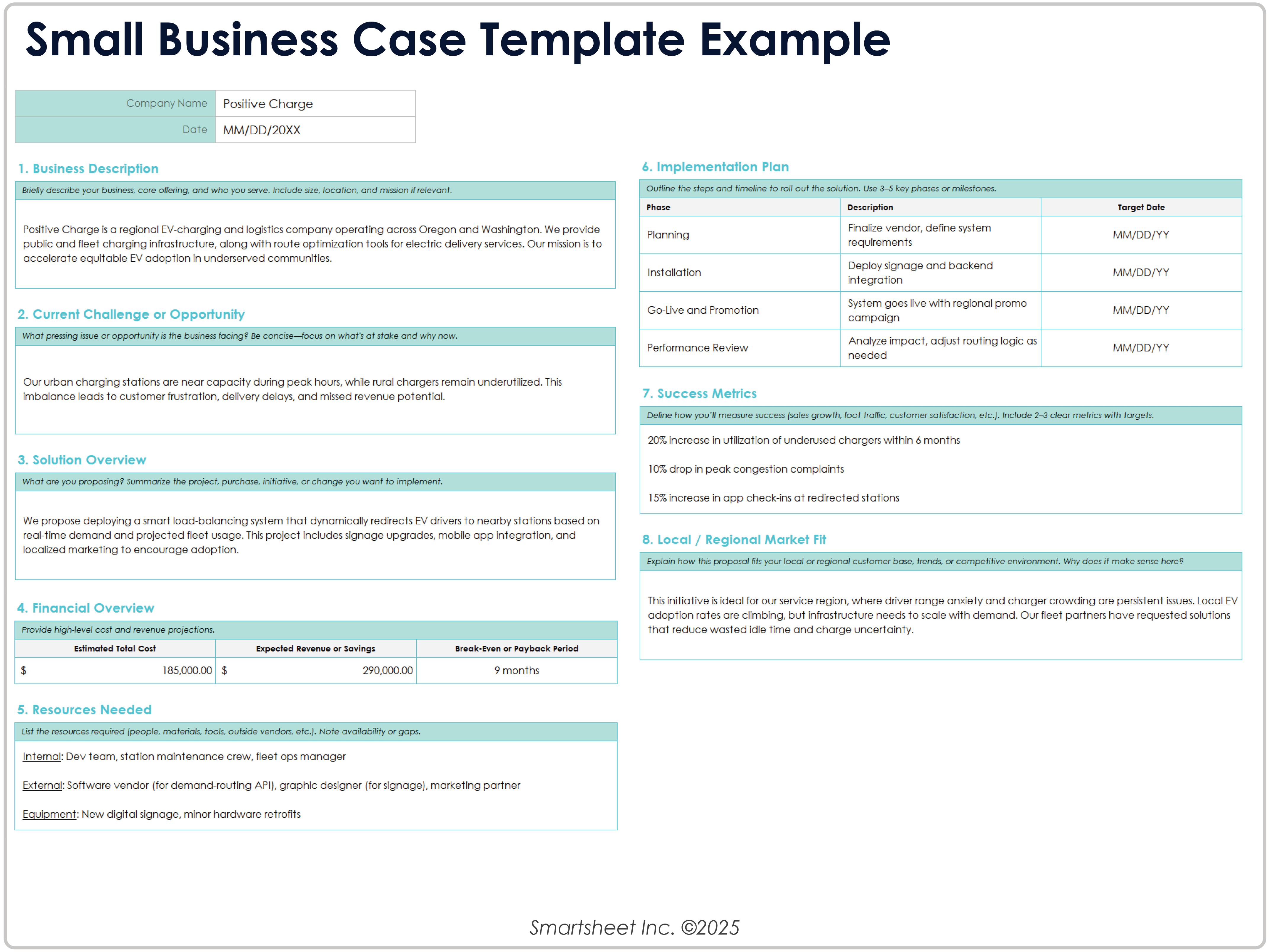
Download Blank and Sample Versions of the Small Business Case Template for
Excel
|
Microsoft Word
When to Use This Template: Small teams or businesses looking to secure approval for equipment, hiring, or expansion in local or regional contexts can use this small business case template. It’s a great alternative to big-enterprise formatting, which may be too much in a small business context.
Notable Template Features: This template’s essential fields include Business Description, Current Challenge or Opportunity, Solution Overview, and Financial Overview. It also includes fields titled Local / Regional Market Fit and Success Metrics to show practical viability.
Strategic Business Case Template
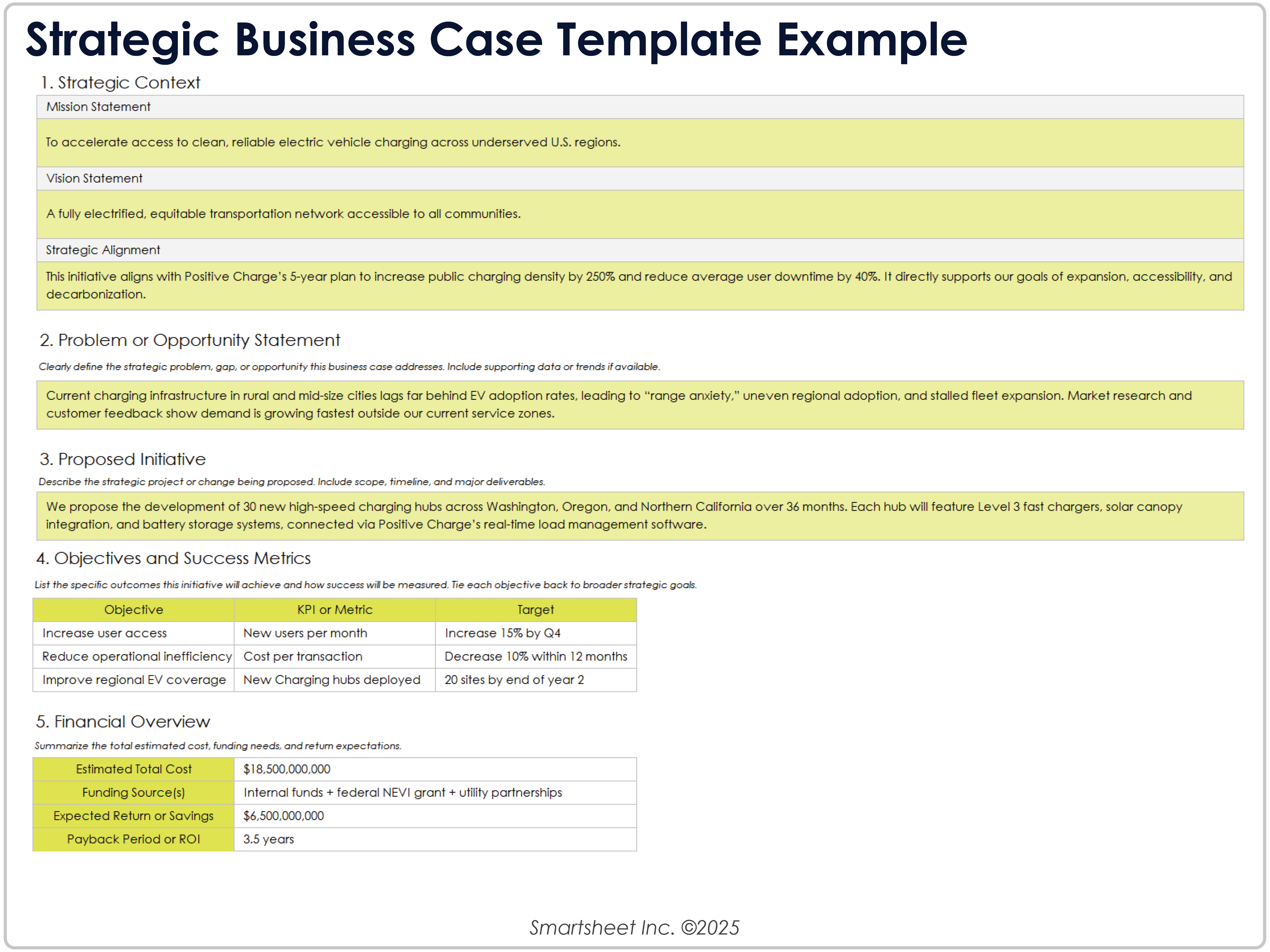
Download Blank and Sample Versions of the Strategic Business Case Template for
Excel
|
Microsoft Word
When to Use This Template: Use this strategic business case template to align initiatives to long-term strategy. Executive sponsors or corporate planning teams can use it to secure buy-in, ensure clear vision, instill confidence, align stakeholders, and acquire serious resources when taking bold steps.
Notable Template Features: This template includes sections to detail the strategic context, objectives and success metrics, and a multi-year implementation roadmap. It also includes a risk and dependency assessment to help teams anticipate obstacles at scale.
Business Case Study Template
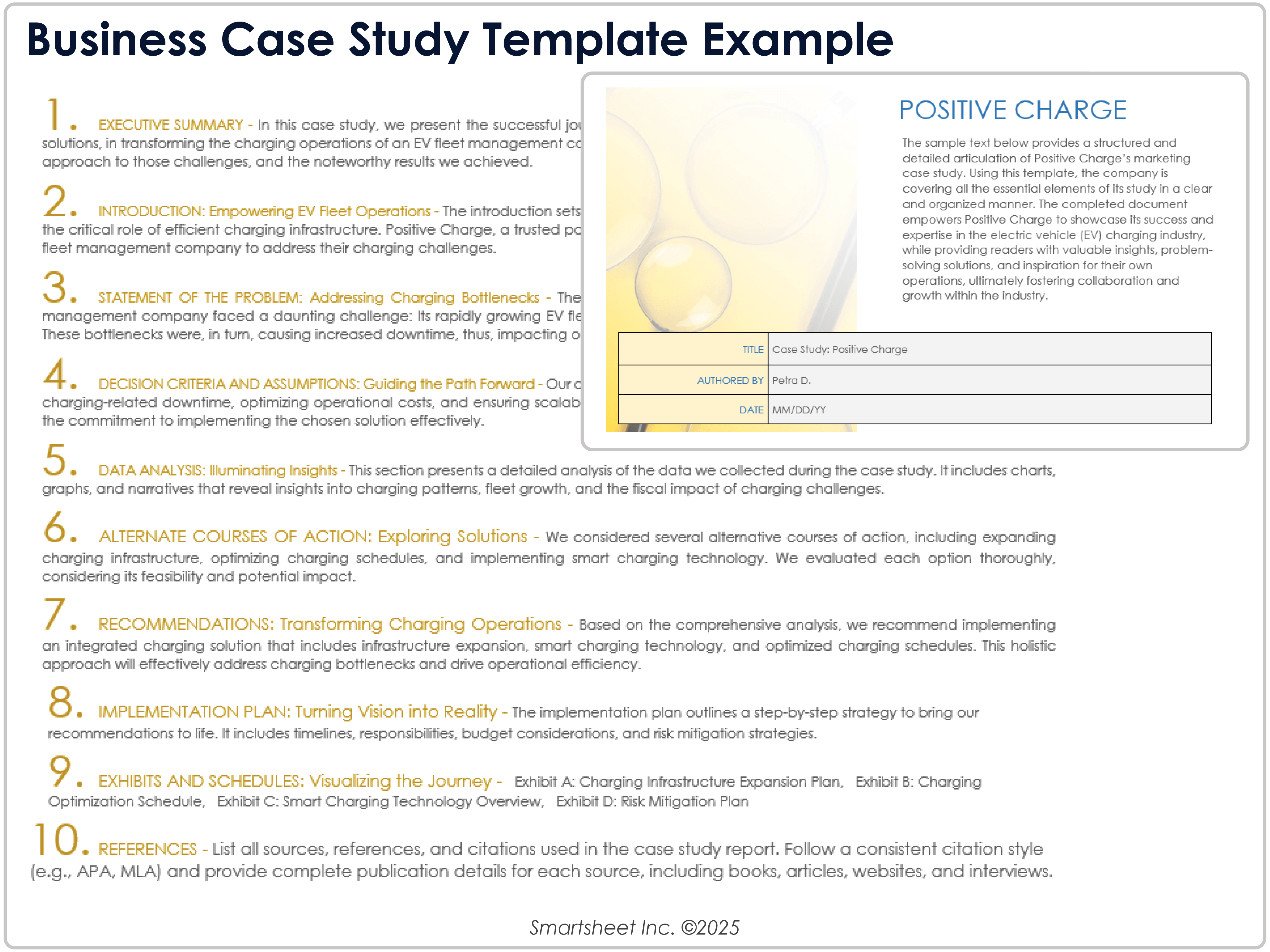
Download Blank and Sample Versions of a Business Case Study Template for
Microsoft Word
|
PowerPoint
| Google Docs | Google Slides
When to Use This Template: Use this business case study template to document completed initiatives and draw out lessons, ROI, or replicable strategies. It’s useful for both internal knowledge sharing and external marketing.
Notable Template Features: This template includes sections to record the business challenge, background, solution implemented, and results or measurable outcomes. Some formats also feature key learnings and optional stakeholder testimonials.
New Product Business Case Template
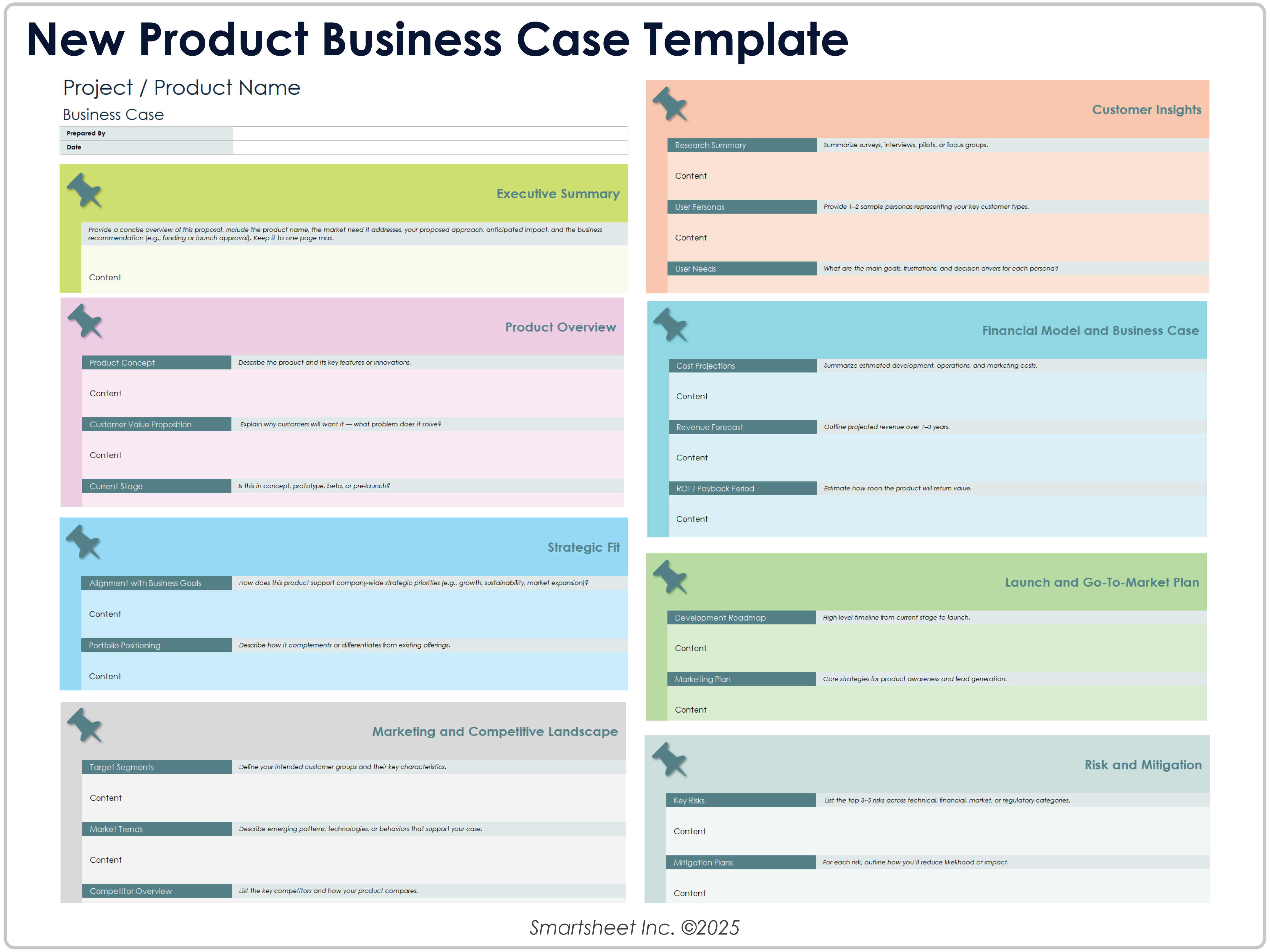
Download a New Product Business Case Template for
Excel
|
Microsoft Word
| Google Sheets
When to Use This Template: Product managers seeking approval to begin R&D or launch planning can use this new product business case template to propose a new offering for development, especially when multiple departments will be involved.
Notable Template Features: This template includes detailed sections titled Product Overview, Strategic Fit, Market and Competitive Landscape, and Customer Insights. The template also includes space for a full financial model and business case, as well as a section called Launch & Go-to-Market Plan.
Marketing Business Case Template
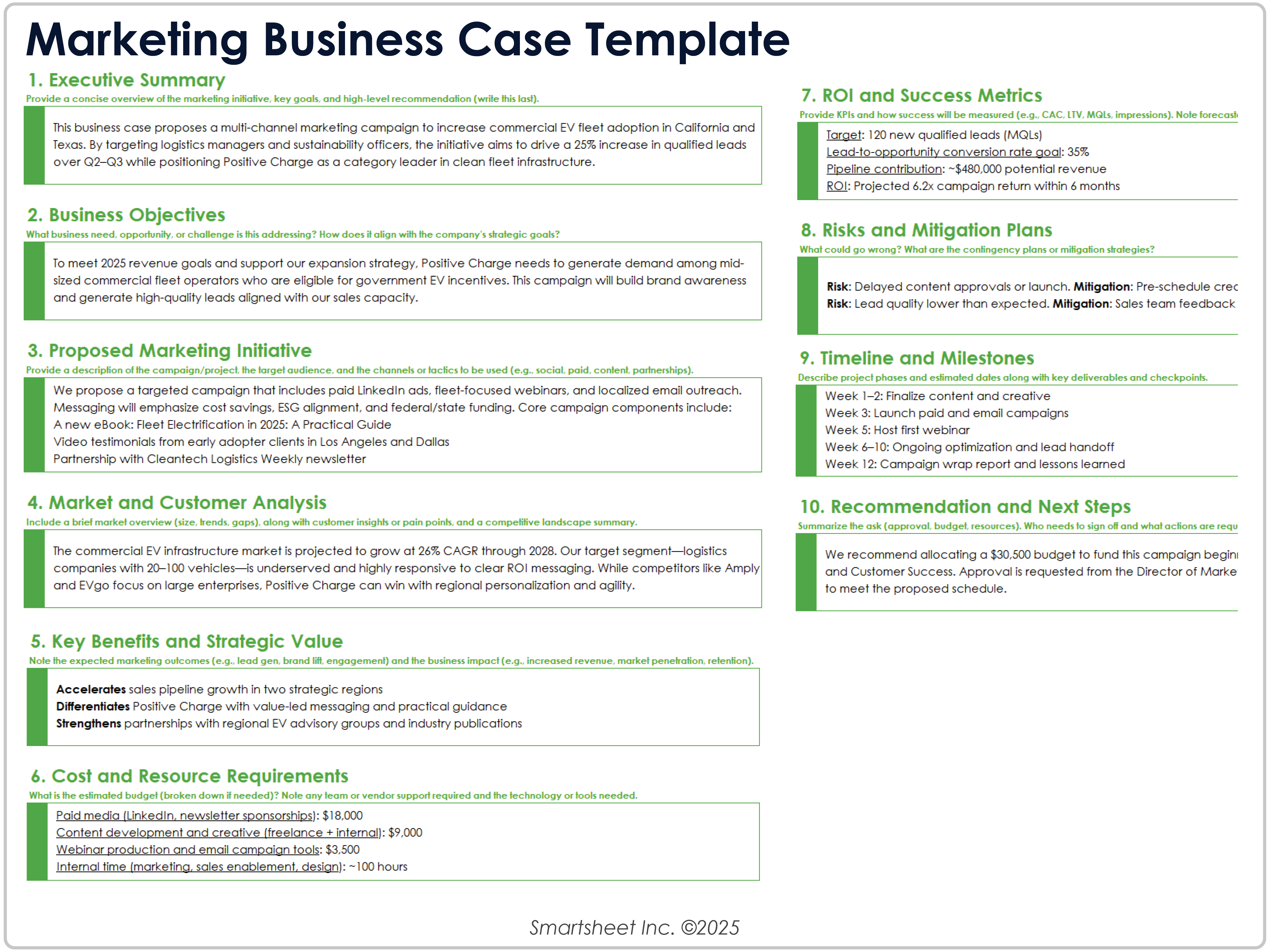
Download Blank and Sample Versions of a Marketing Business Case Template for
Excel
|
Microsoft Word
|
PowerPoint
When to Use This Template: Use this marketing business case template to turn creative plans into strategic, stakeholder-backed actions. It can help you increase market share or tackle a rebranding effort.
Notable Template Features: This template contains structured areas to detail your business objective, the proposed marketing initiative, and market and customer analysis, as well as a section called ROI and Success Metrics. The final section for recommendations and next steps facilitates quick decision making.
Technology Business Case Template
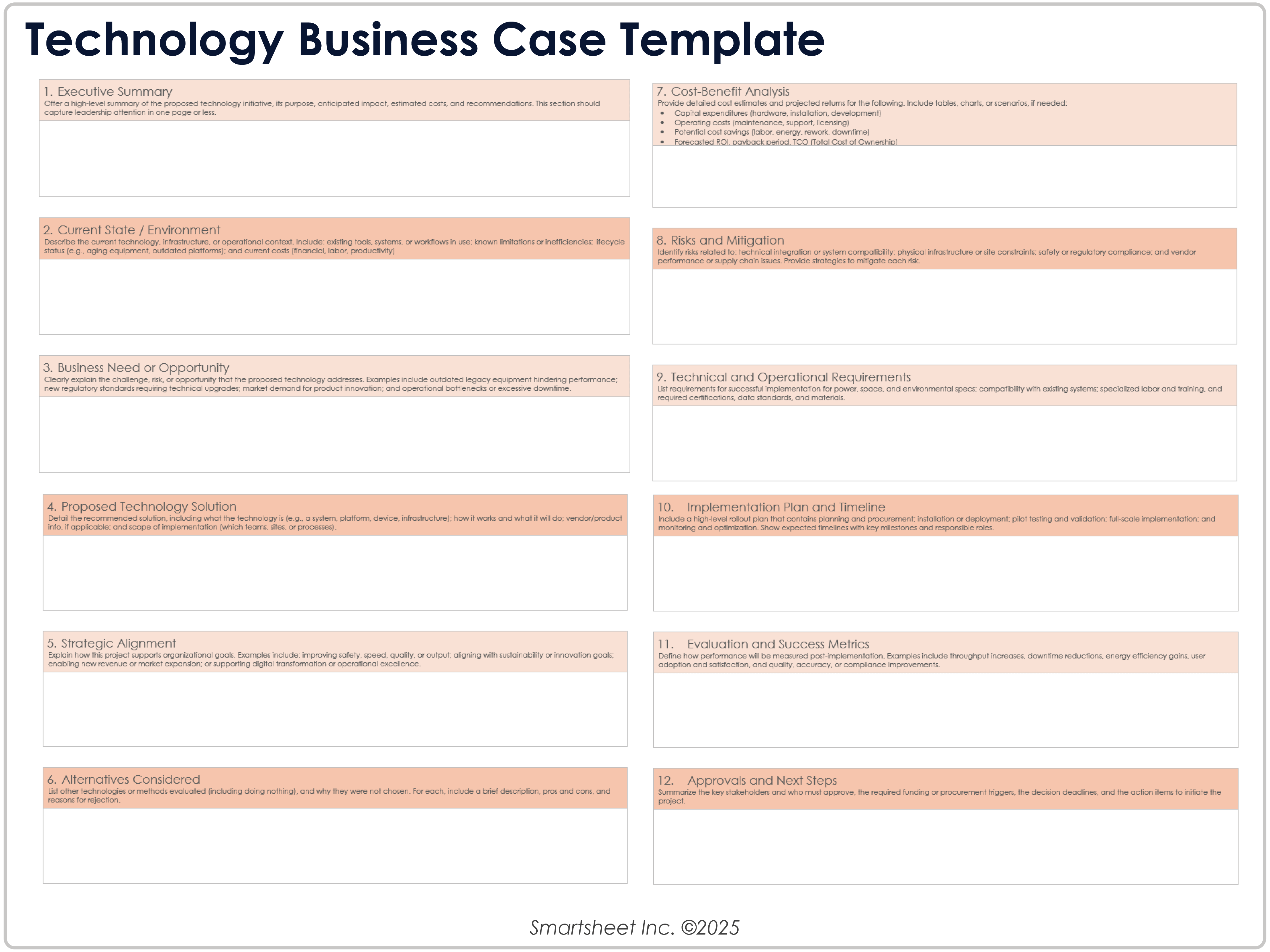
Download a Technology Business Case Template for
Microsoft Word
|
Adobe PDF
When to Use This Template: Use this technology business case template to pitch information technology (IT) infrastructure upgrades, new systems, or technical investments. It’s well-suited for CIOs, IT leads, or operations managers who need to build support for complex implementations.
Notable Template Features: This template provides space to record the current state or environment, the proposed technology solution, the cost-benefit analysis of the solution, and any technical and operational requirements. The template also includes an implementation plan and timeline, and a section for evaluation and success metrics.
HR Business Case Template
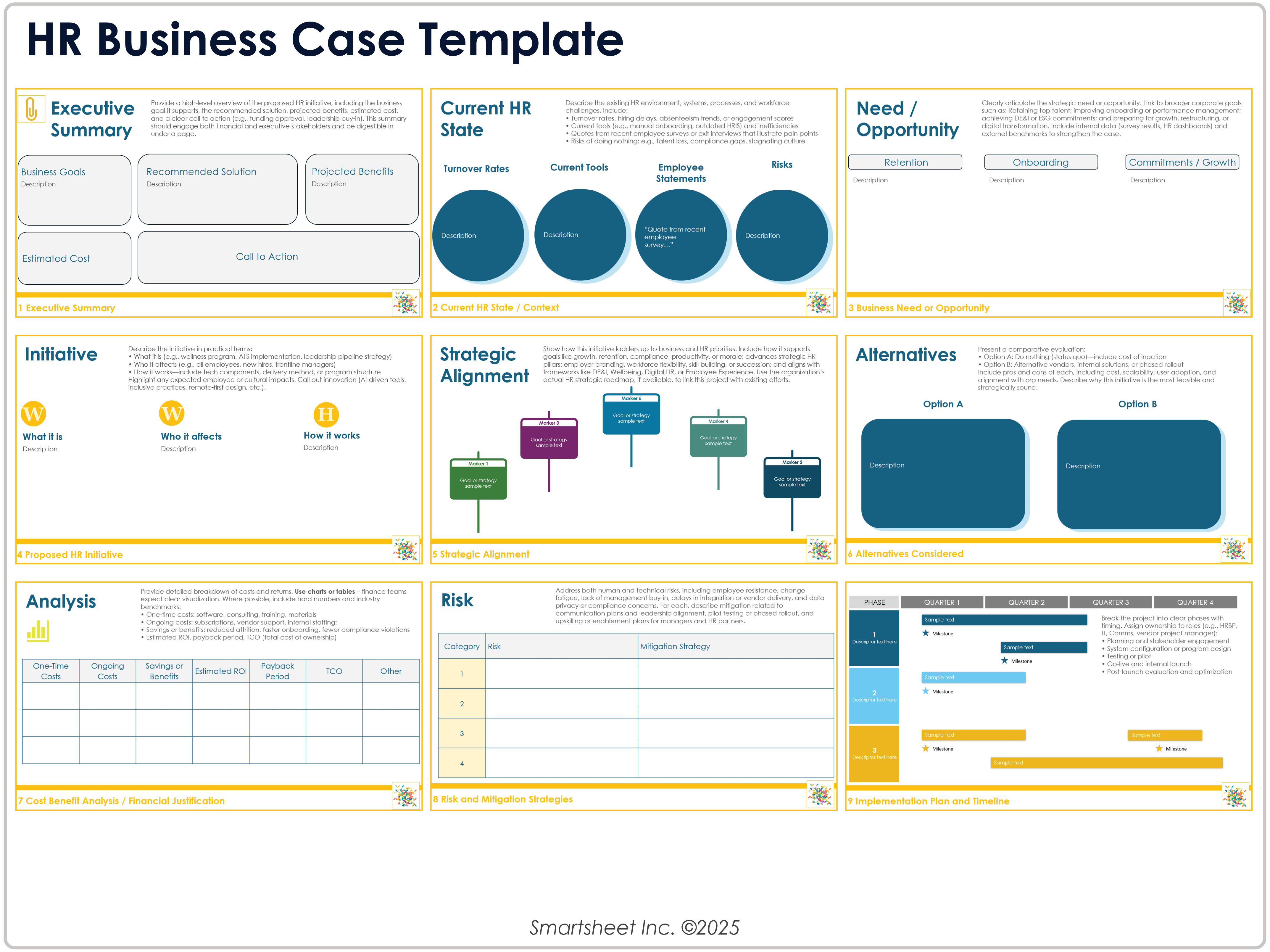
Download an HR Business Case Template for
Microsoft Word
|
PowerPoint
When to Use This Template: Use this HR business case template to make a persuasive, data-backed case for investing in people to drive business results. For example, it works as a tool to rethink hiring, boost engagement, or reshape workplace culture.
Notable Template Features: This template includes detailed fields called Current HR State/Context, Proposed HR Initiative, Strategic Alignment, and Cost–Benefit Analysis/Financial Justification. Additional sections called Implementation Plan & Timeline and Success Metrics/KPIs ensure accountability.
Capital Expenditure Business Case Template
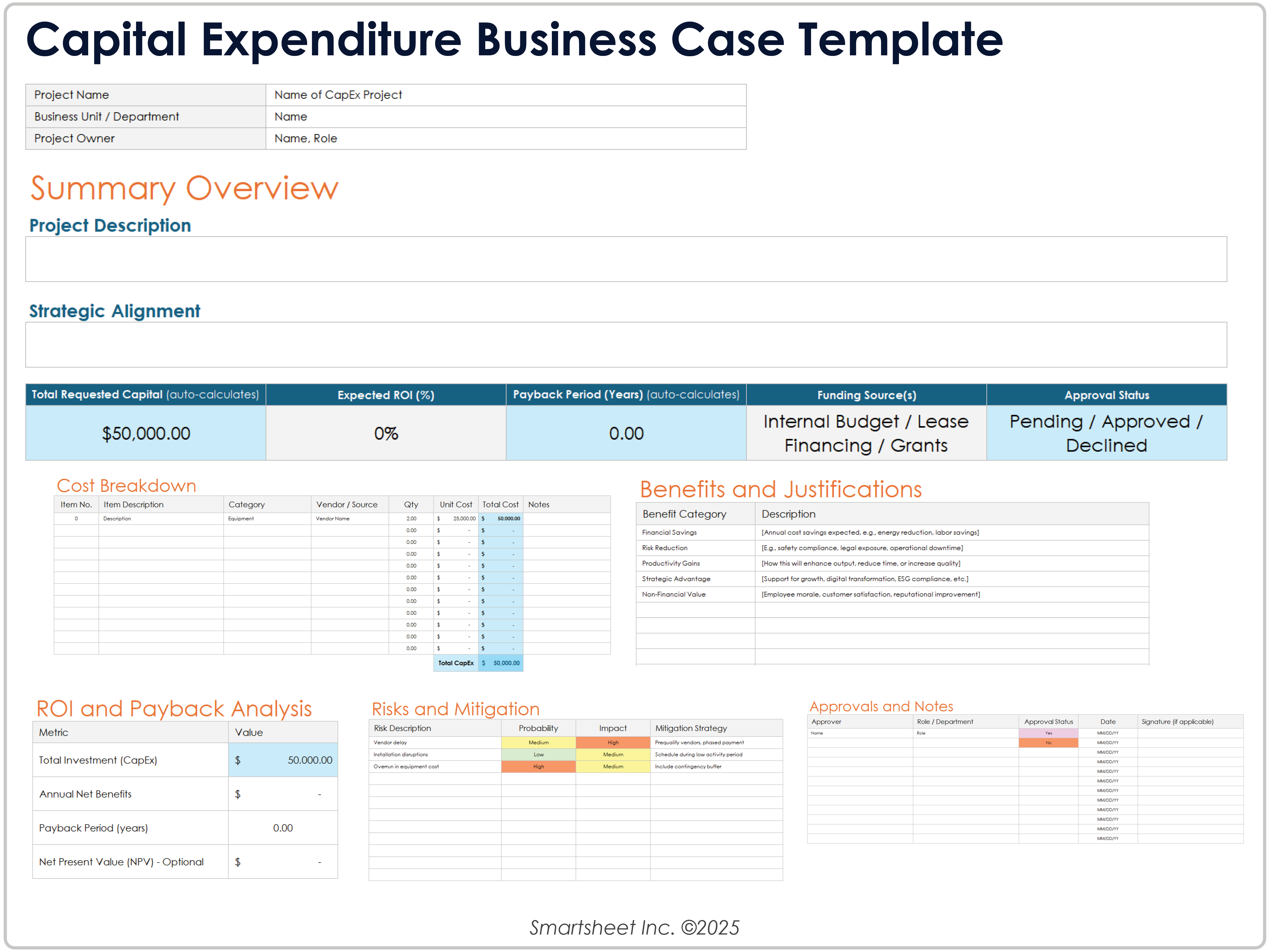
Download a Capital Expenditure Business Case Template for
Excel
| Google Sheets
When to Use This Template: Finance teams, operations leads, and department heads can use this capital expenditure business case template to justify major investments — from new equipment to large-scale systems — by connecting upfront costs to long-term value. Use it to provide a clear ROI, present compelling data, and add credibility to funding requests.
Notable Template Features: The template includes space for a summary overview, cost breakdown, and benefits and justification, with formulas for calculating ROI and analyzing payback. Other tabs like Risks & Mitigation and Approvals & Notes support financial review and sign-off.
Tips for Creating a Compelling Business Case and Business Case Template
The best way to build a compelling business case is to focus on clarity, outcomes, data-driven solutions, and strategic value. The right tool, like a business case template, helps frame the problem, justify the solution, and spotlight benefits to persuade stakeholders.
When creating a compelling business case and business case template, focus on the following:
- Data-Driven Solutions: Great business cases earn trust by connecting real challenges to credible, well-backed solutions. Use a business case template to map out costs, timelines, and ROI with hard data and clean visuals.
- Outcome Focus: Tie every point to measurable results that speak to stakeholders, like increased revenue, cost savings, efficiency gains, or competitive advantage. This will keep the focus on impact and help stakeholders see exactly what success will achieve.
- Clarity: When creating a business case, focus on bottom line impact and feasibility to appeal to executives and teams. Avoid jargon and state your pitch clearly: what matters, why it works, and what success looks like.
- Strategic Alignment: Show how your proposal supports broader organizational goals, market positioning, or long-term growth so that stakeholders recognize it as a natural fit for the company’s direction. This can include a value proposition to clearly outline the benefits of your case over alternatives.
- Risk Awareness: Anticipate and address potential concerns, demonstrating that you’ve thought through obstacles and built in strategies to overcome them.
- Tools: Use the right tools and templates to make a persuasive case with an organized structure. Every section (budget, risks, implementation, etc.) should work together to show your idea is smart, scalable, and ready to deliver.
Improve Your Business Cases With Smartsheet for Project Management
Empower your people to go above and beyond with a flexible platform designed to match the needs of your team — and adapt as those needs change.
The Smartsheet platform makes it easy to plan, capture, manage, and report on work from anywhere, helping your team be more effective and get more done. Report on key metrics and get real-time visibility into work as it happens with roll-up reports, dashboards, and automated workflows built to keep your team connected and informed.
When teams have clarity into the work getting done, there’s no telling how much more they can accomplish in the same amount of time. Try Smartsheet for free, today.